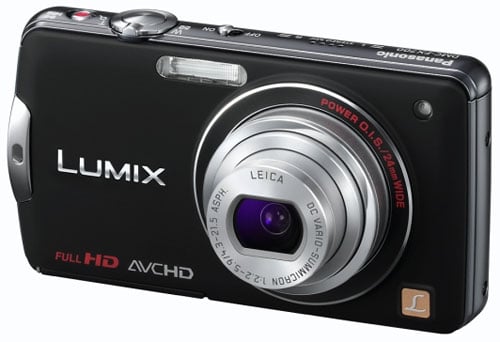Panasonic Lumix DMC-FX700
-
-
Written by Gordon Laing
Panasonic Lumix DMC-FX700 verdict
The Panasonic Lumix FX700 is a 14 megapixel compact with a 5x stabilised zoom and a 3 inch touch-screen display. At its heart is a newly engineered 14 Megapixel CMOS sensor which combined with the latest Venus FHD processor provides a range of fast burst modes and full HD video recording at 1080i as well as 720p resolutions.
The Lumix FX700’s zoom lens has a super-wide 24mm equivalent starting point extending to 120mm equivalent at the telephoto end with a fast f2.2 maximum aperture at the wide angle setting.
The FX700 has all the features you’d expect to find in a consumer-oriented compact including face detection AF, face recognition, scene detection and a wide range of scene modes. It also has sophisticated automated features for improving image quality such as intelligent exposure and intelligent ISO and offers extended control over exposure with PASM exposure modes.
 |
Compared to Sony Cyber-shot DSC-TX9
The Lumix FX700 and Cyber-shot TX9 may look very different, but share many similarities. The main reason we’ve compared them is, of course, that they’re both touch screen models. They also both have CMOS sensors that provide them with full HD video recording and impressive burst shooting capabilities.
So what sets them apart? Well, the TX9’s touch screen is significantly larger than the FX700’s, the icons are bigger and operation is simpler and more straightforward. It also has a higher resolution better quality screen than the FX700. The FX700 on the other hand sports a fast 5X optical zoom that outreaches the TX9’s at both ends of the range, albeit only marginally wider. It also has a higher resolution image sensor, but as we’ve seen in our quality tests where the Cyber-shot TX9 outperformed the Lumix FX700, size, at least in this case, isn’t everything.
Both cameras have similar video recording features with both able to shoot full HD 1080i footage, the FX700 scores extra points for the ability to continue to shoot stills, even in burst mode, while video recording. Of much more interest to those who want to go beyond mere point-and-shoot operation. though, will be the FX700’s manual and semi-auto PASM exposure modes. But then the Sony boasts innovative modes which exploit the fast shooting to combine multiple frames to reduce noise or motion blur. These combined with the great screen and good looks will ensure many fans.
See our Sony Cyber-shot DSC-TX9 review for more details.
Compared to Nikon COOLPIX S80
Again, while the Lumix FX700 and COOLPIX S80 share some features in common, they are actually very different cameras both to look at and to use. Both have a 14 Megapixel sensor, 5X optical zoom lens and a touch screen. For us, the Lumix FX700’s 24-120mm equivalent zoom range is a better use of the 5x range than the Nikon’s 35-175mm equivalent, but not everyone will share that view.
The COOLPIX S80’s 3.5 inch OLED screen is superior to the Lumix FX700’s and, as we said with the Cyber-shot TX9, it’s about more than just size. But the FX700 has plenty of features to outweigh what the COOLPIX has to offer. It has more video modes including 1080i full HD, you can shoot stills while recording video and shoot fasts burst of full resolution images (at the same time as recording video if you want). It offers greater control over focusing and metering modes and has fully manual and semi-automatic exposure modes.
Lastly, the FX700 has real buttons. That’s not so much a feature as a marker of the different approach inherent in these two models. You could sum it by saying the COOLPIX S80 is a sylish high-end point-and-shoot touch-screen compact that puts simplicity of operation at the forefront, while the FX700 is a capable feature-packed compact that also happens to have a touch screen.
See our Nikon COOLPIX S80 review for more details.
Also consider: Canon IXUS 210 / PowerShot SD3500 IS
– see our Canon IXUS 210 / SD3500 IS review.
Panasonic Lumix DMC-FX700 verdict
Though it’s a touch-screen model, the Panasonic Lumix FX700 is, as we’ve seen, a very differrent kind of compact to the two other touch-screen models we’ve compared it to – the Sony Cyber-shot TX9 and the COOLPIX S80.Where those cameras put the touch-screen at the centre of things, the Lumix FX700 uses it as a useful adjunct to the physical controls. Where Sony and Nikon have gone for style and simplicity, Panasonic has opted for features and functionality.
The Lumix FX700 is a very capable touch-screen camera packed full of features aimed at every kind of photographer from casual snappers to those who take their photography a little more seriously. The danger is that, though it has scene detection, face recognition, intelligent exposure and all the other consumer-friendly features, the proliferation of touch icons in addition to physical controls will turn off those who just want to point and shoot without encumberances. And if image quality is high on your list of must haves, the fact that the FX700 came a poor third in our real-life outdoor and high ISO noise tests is going to be hard to ignore.
For our part, the more we used the Lumix FX700, the better it got. In some ways it has more in common with Canon’s IXUS 210 / SD3500 IS than either the Sony Cyber-shot TX9 or the Nikon COOLPIX S80. But if you’re looking for a touch-screen compact that doesn’t sacrifice control and advanced modes and offers excellent value for money the Lumix FX700 has got to be a very strong contender
Bad points | Scores (relative to 2010 compacts) |
 | ||
Build quality: Image quality: Handling: Specification: Value:
Overall: |
18 / 20 14 / 20 16 / 20 17 / 20 17 / 20
82% | |||






